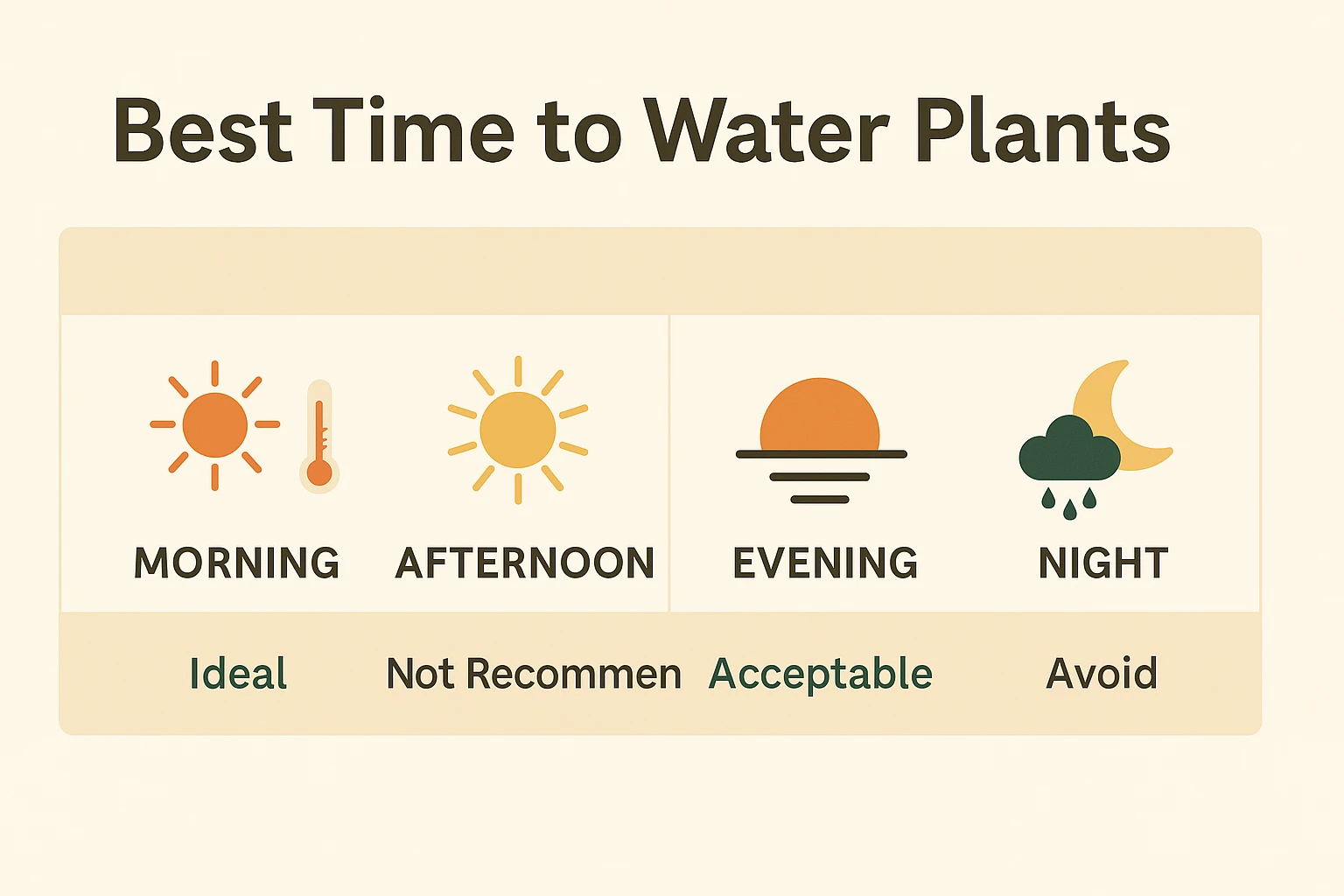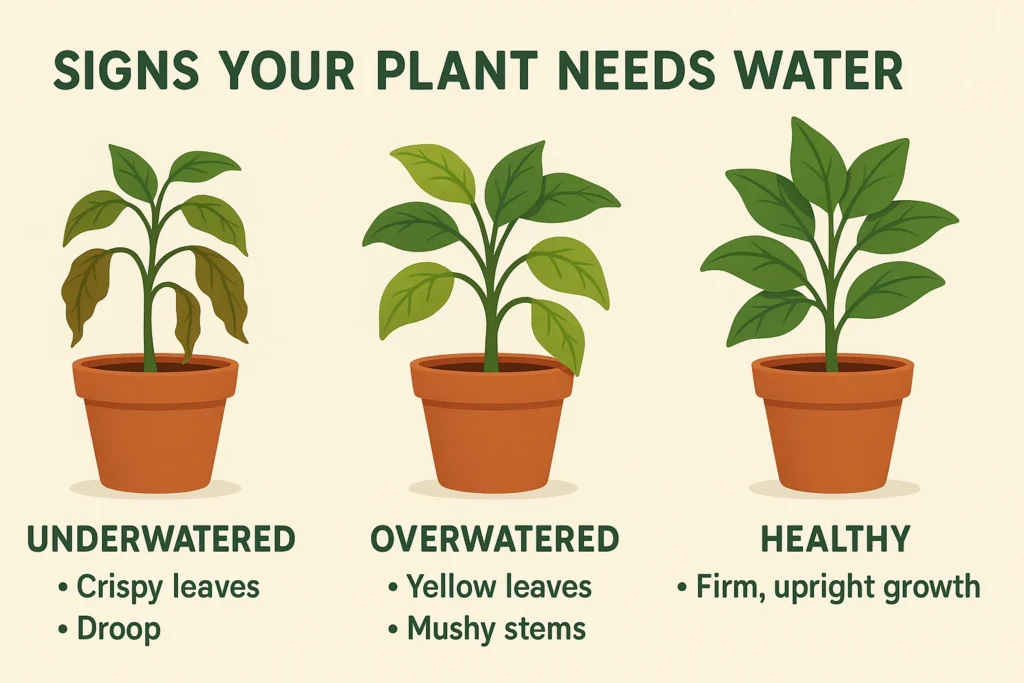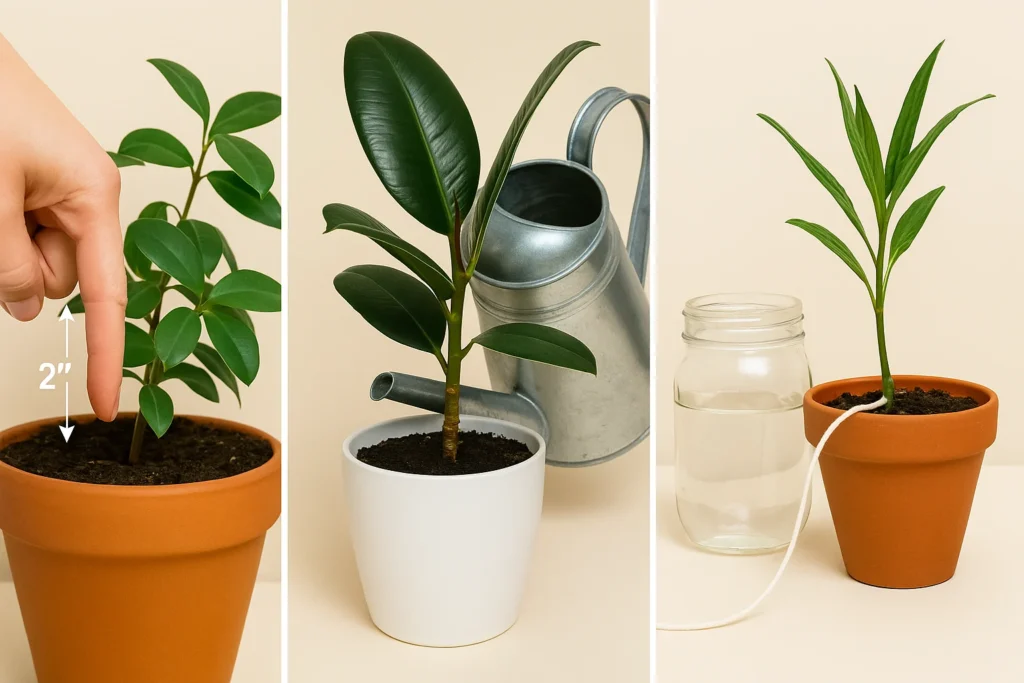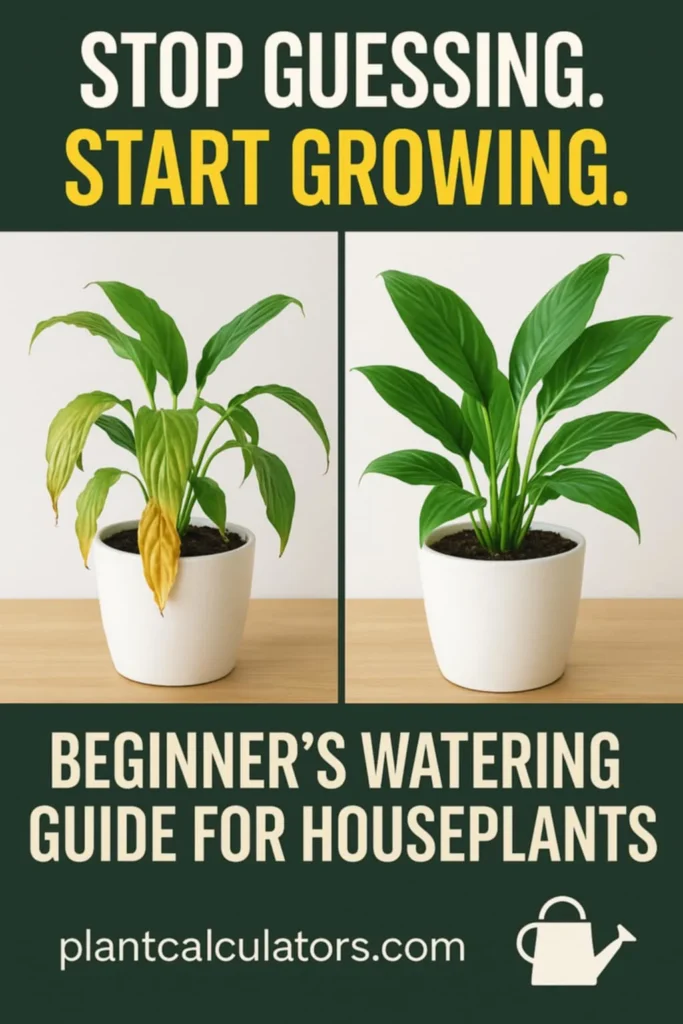When to Water Plants: The Ultimate Guide to Keeping Them Healthy

It doesn’t matter whether you’re a seasoned plant parent or you just brought home your first pothos—one of the most common questions people ask is when to water plants. And truthfully, there’s no single right answer.
Watering plants is less about sticking to a strict schedule and more about paying attention. What type of plant do you have? What’s the season? How’s your lighting, airflow, or pot drainage? These aren’t just details—they’re the difference between lush growth and limp leaves.
If you’ve ever asked yourself is it better to water in the morning or evening, or wondered how to water plants when on vacation, you’re not alone. We’ve heard every variation of this concern, and this guide was made to answer them all—based on real results, field-tested tools, and practical plant wisdom.
Throughout this guide, you’ll learn not just when to water plants, but how to read them, how to adjust for seasons, and how to keep them happy when you’re not home. Plus, you’ll find a free watering calculator, expert-backed tips, and links to our most popular guides.
For deeper houseplant care backed by horticulture experts, check out this resource from the University of Illinois Extension.
Now let’s dig into the soil—literally—and get clear on what your plants are really asking for.
Table of Contents
What Does Watering My Plants Do?
At the most basic level, watering is how you deliver life. But what does watering your plants actually do beyond keeping the soil damp?
Water acts as the plant’s transport system. It carries essential nutrients from the soil into the roots, up the stem, and out to every single leaf. Without it, the entire operation stalls. But it’s not just about nutrients—it’s also about temperature control and structure.
Plants rely on water pressure inside their cells (a process called turgor) to stand tall. Miss a few days, and suddenly your peperomia’s perky leaves start drooping like wet paper. Overdo it, and those same roots can suffocate in soggy soil, unable to take in oxygen. That’s why knowing when to water plants matters just as much as how much.
And here’s the thing: every species handles moisture differently. Ferns, for instance, evolved in rain-soaked understories and crave constant humidity. Cacti, on the other hand, are desert survivalists built to go weeks bone-dry.
Bottom line? Water isn’t a routine—it’s a relationship. You’re not just quenching thirst. You’re supporting growth, nutrient uptake, and the daily function of your plant’s entire system.
How Often Should You Water Plants?
Let’s cut to it—how often should you water plants? The honest answer: it depends. There’s no universal schedule that works for every plant in every home. But understanding what factors influence watering needs gives you the edge.
Here’s what you need to consider:
- Plant species – A pothos and a lavender aren’t playing by the same rules.
- Pot type and size – Terra cotta dries faster than plastic. Small pots dry faster than large ones.
- Soil composition – Chunky mixes hold less water than heavy, moisture-retentive ones.
- Light exposure and temperature – Plants in bright, warm areas dry out faster.
- Humidity and airflow – High humidity = slower drying. Air vents = faster.
Most houseplants appreciate a good soak when the top 1–2 inches of soil feel dry. For succulents and cacti, wait until the soil is bone-dry all the way through. Tropical plants often like consistently moist (not soggy) conditions. You’ll get to know each plant’s rhythm over time.
Growing tomatoes? Watering frequency changes drastically depending on whether you’re growing seedlings, transplants, or fruiting plants. Read our full guide on how to water tomatoes at every stage to avoid overwatering mistakes.
So when you ask when to water plants, you’re really asking: “What’s this plant’s background? How fast is the soil drying? What’s happening in my space?” That’s the approach that leads to healthy, thriving growth.
Signs Your Plant Needs Water
You shouldn’t be guessing when to water plants. The good news? Most plants are pretty good at telling you what they need—you just have to know what to look for.
Here’s a breakdown of the most common signals:
Dry Soil (The Finger Test Still Works)
Stick your finger about two inches into the soil. If it feels dry at that depth, it’s usually time to water—unless you’re growing drought-tolerant plants like succulents. For moisture-loving plants, don’t let the soil dry out completely.
Drooping or Wilting
Wilting leaves are a classic sign of dehydration—but don’t rush for the watering can just yet. Wilting can also mean overwatering. The key is to check the soil. If it’s wet and your plant is still wilting, you’ve gone too far.
Crispy or Curled Leaf Edges
If the edges of your leaves are turning brown and crispy, your plant is likely thirsty, especially if humidity is low. Tropical plants like calatheas and ferns are extra sensitive to dry air.
Yellowing Leaves
One of the trickiest signs. Yellow leaves can point to too much water, not too little. This is why checking the soil is critical every single time before watering.
Need more help decoding your plant’s distress signals? Try our Indoor Plant Watering Calculator to get personalized watering tips based on light, plant type, and pot size.
Knowing when to water your plants often comes down to paying attention. Plants speak through their leaves, stems, and soil—tune in and they’ll tell you what’s wrong.
Best Time of Day to Water Plants
The best time to water your plants is in the early morning. This allows the soil to absorb moisture before the heat of the day, reducing evaporation and giving plants the hydration they need to thrive. If mornings aren’t possible, early evening is the next best option—just make sure leaves have time to dry before nightfall to prevent fungal issues. Avoid watering during midday heat when water evaporates too quickly and can stress plants.
But what if mornings aren’t an option?
Watering in the early evening can work—just make sure there’s still enough light and airflow for any surface moisture to evaporate. What you want to avoid is watering late at night. Damp leaves and dark conditions make a cozy home for rot, mold, and mildew.
Here’s the quick rundown:
- Morning (ideal) – Boosts hydration and reduces disease risk.
- Early evening (acceptable) – Fine if mornings aren’t doable.
- Night (avoid) – Can promote fungal problems and root rot.
No matter when you water, consistency matters more than perfection. Once you understand when to water plants, timing becomes part of a routine that supports natural growth rhythms.
Use Our Indoor Plant Watering Calculator
Knowing when to water your plants shouldn’t feel like a guessing game. That’s exactly why we built our Indoor Plant Watering Calculator — to take the stress and uncertainty out of the equation.
This tool considers what really matters:
- Your plant’s species
- Pot size and drainage
- Room temperature and humidity
- Natural light levels
Plug in those details, and it’ll tell you exactly how often to water and how much to use. Whether you’re caring for a moisture-loving peace lily or a bone-dry snake plant, the calculator adjusts to your setup.
How Plant Type Affects Watering Frequency?
If there’s one truth about plant care, it’s this: no two species are alike. Knowing when to water plants means understanding where they come from—and what they’re built to handle.
Succulents & Cacti
Think desert survivalists. These plants evolved to store water in their thick leaves and stems. Succulents like echeveria or haworthia want their soil bone-dry before you even think about watering again. For them, once every two to three weeks is often enough—especially in cooler months.
Tropical Houseplants
Plants like monsteras, philodendrons, and peace lilies trace their roots to humid jungle floors. They prefer consistently moist soil (but not soggy). Check them once or twice a week, depending on light and pot size. A layer of mulch or a humidity tray can help, especially if your home is dry.
Ferns
Ferns like Boston or maidenhair varieties don’t mess around—they’ll crisp up fast if the humidity drops or their soil dries out. These forest-floor dwellers like moisture on their terms: damp soil, misted foliage, and indirect light. Water 2–3 times a week and never let them fully dry out.
Snake Plants & ZZ Plants
These are the tough guys of the houseplant world. Native to arid environments, they’ll thrive on neglect. Water only when the soil is completely dry—every two to four weeks depending on season and light.
Each plant has its own internal clock, and learning when to water plants means syncing your care routine with their natural rhythm. Use our watering calculator to get species-specific recommendations, and you’ll avoid the trap of one-size-fits-all watering.
Let soil dry completely
Keep soil slightly moist
Don’t let soil dry out
Dry soil between waterings
Seasonal Adjustments: Watering by Weather
The calendar matters just as much as your watering can. Temperature shifts, daylight hours, and humidity changes all affect when to water your plants—and how much they actually need.
Summer
Longer days and higher heat mean faster evaporation. Your plants drink more, dry out quicker, and need watering more often. For sun-lovers like herbs, tomatoes, or spider plants, that might mean checking soil daily. Grouping plants together can also raise humidity and reduce stress from direct sunlight.
Fall
This is a transition season. As daylight shortens, plant growth slows. Begin spacing out your watering and reduce volume. Watch for signs of overwatering, especially in plants that were once in full growth mode.
Winter
In colder months, indoor heating systems dry the air, but your plants aren’t growing as much. It’s easy to overwater when they’re dormant or semi-dormant. Let the soil dry more thoroughly before watering again—especially for low-light species.
Planning travel during the holidays? Figuring out how to water plants when away is easier in winter. Most will be fine for a week or two if you water thoroughly before leaving and move them away from direct sun or radiators.
Spring
Growth kicks back in, and so does thirst. Begin watering more frequently again—but monitor the soil. Some plants will wake up faster than others.
Paying attention to seasonal rhythms is one of the best ways to master when to water plants. It’s less about the calendar and more about what your plant is telling you right now.
Watering Techniques That Actually Work
There’s more to watering than filling a can and giving your plants a sprinkle. The way you water matters just as much as when to water plants. Use the right techniques, and you’ll encourage deeper roots, stronger growth, and fewer pest or fungal issues.
✅ Water Deep, Not Just Often
Give your plant a proper soak—don’t just wet the topsoil. Water until you see it draining out the bottom. This encourages roots to grow downward rather than clustering at the surface, which makes your plant more drought-tolerant over time.
✅ Avoid the Foliage
Water directly at the base of the plant. Wet leaves are a magnet for fungal problems like powdery mildew and root rot—especially in dense or shady spots. Use a watering can with a narrow spout or a squeeze bottle for precision.
✅ Use the Right Tools
- Moisture meters take the guesswork out of soil checks.
- Self-watering pots or watering globes are ideal if you forget or travel frequently.
- For large setups, drip irrigation saves time and conserves water.
✅ Vacation Hacks
Need to know how to water plants when on vacation? Here are three low-maintenance options:
- Water well before you leave, then group plants to boost humidity.
- Place pots on a damp towel inside a shallow tray.
- Use a water wick system (a jar of water + cotton string) for slow, consistent moisture.
Mastering these methods is just as important as timing. Get both right, and when to water plants becomes less of a chore—and more of a rhythm.
FAQs on Watering Plants
Even with the best advice, watering plants still raises a few head-scratchers. Here are quick answers to some of the most frequently asked questions—based on what real plant parents ask us all the time.
How do I know if I’m overwatering?
The most obvious signs are soggy soil, yellowing lower leaves, and a funky, musty smell near the base of the plant. Overwatering cuts off oxygen to the roots, essentially drowning them. Always check soil moisture before adding more. Remember, knowing when to water plants often means knowing when not to.
Is tap water bad for plants?
Most houseplants are fine with regular tap water, but sensitive ones like calatheas or spider plants can develop brown tips if chlorine or fluoride levels are high. Letting water sit out for 24 hours (to let chemicals evaporate) is a cheap fix. You can also use filtered or distilled water for fussier plants.
What’s the best way to water from the bottom?
Bottom watering can help if your soil has compacted or roots are struggling. Set your pot in a tray of water for about 20–30 minutes, letting the soil absorb moisture through the drainage holes. Then remove the pot and let excess water drain fully.
Is it okay to mist my plants?
Only if they like humidity. Misting benefits tropical plants like ferns and calatheas, but it won’t replace regular watering. It also shouldn’t be used on fuzzy-leaved plants (like African violets) which can rot from moisture on their foliage.
What’s the best trick for how to water plants when on vacation?
Use a self-watering globe or setup a slow-drip system using a cotton string and a jar of water. Or, better yet—ask a plant-savvy neighbor and leave them with clear notes. And yes, our watering calculator includes prep tips for short and long getaways.
If you’re ever unsure, check the soil and recheck your plant’s specific needs. The more you tune in, the easier it gets to understand when to water plants and when to hold off.
How do I know when to water my plant?
Start with the soil. Stick your finger about 1–2 inches deep. If it feels dry, it’s probably time to water—unless it’s a drought-tolerant species like a cactus. You can also watch for signs: droopy leaves, crispy edges, or lightweight pots (they feel much lighter when dry). Getting to know when to water plants is about combining observation with routine.
When should we not water the plants?
Avoid watering when the soil is already damp or when the plant is in a dormant phase—especially during winter. Overwatering in these conditions can lead to root rot and fungal problems. Also, steer clear of watering during the hottest part of the day when moisture evaporates too quickly, or late at night when water lingers on leaves and soil.
Does a plant need water at night?
Generally, no. Most plants are less active at night and won’t absorb water as efficiently. Watering late in the evening can also leave foliage damp overnight, which increases the risk of mildew or rot. For most plants, morning is the ideal time. If you’ve ever asked is it better to water in the morning or evening, the answer is almost always morning.
Final Thoughts: Mastering When to Water Plants
Watering isn’t just part of plant care—it’s the heartbeat of it. From understanding plant species to syncing with the seasons, knowing when to water plants means moving beyond guesswork into intentional, informed care.
If there’s one takeaway, it’s this: don’t rely on a fixed schedule. Instead, read the soil, observe your plants, and use the tools available to build a routine that works for your specific setup. The more tuned in you are, the less you’ll need to rely on trial and error.
Keep Growing with Our Most Popular Resources:
- ✅ Indoor Plant Watering Calculator – Personalized guidance for your exact setup
- ✅ Stop Overwatering: A Complete Guide to Watering Tomato Plants – Tips for every growth stage
- ✅ How to Water Plants While on Vacation – Low-maintenance care plans that work
- ✅ Soil Calculator– Because the right soil changes everything
- ✅ Soil pH Calculator
🌱 Want expert-approved tips on indoor plant care? Explore this houseplant guide from the University of Illinois Extension — it’s packed with research-backed advice for every plant lover.
Thanks for reading—and happy watering.



